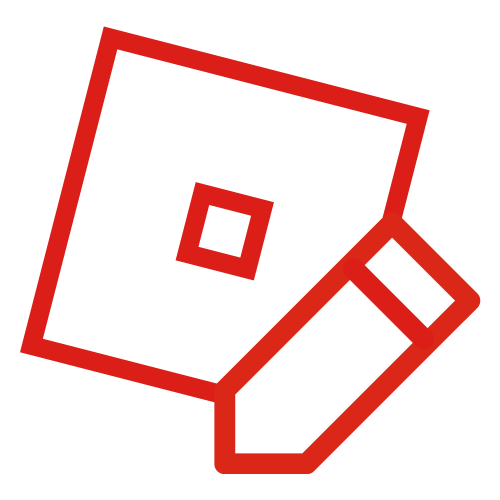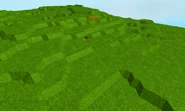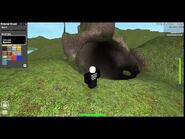- For the class type, see Terrain.
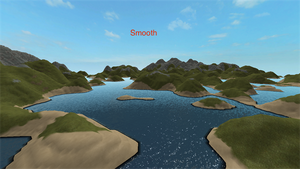
A screenshot showing off the Terrain.
Terrain is a voxel-based mesh that, unlike parts, can be modified through the Terrain object which is parented to the Workspace. The Terrain object cannot be destroyed nor parented. The physics and rendering of the mesh is handled by the Roblox's engine. Terrain can also be modified in Roblox Studio using the Terrain Editor menu.
There are advantages to using Terrain as a way of creating terrain environments rather than using parts: many Materials used in the mesh are smooth which resembles terrain in the real world more than parts, and terrain is only made up of one mesh that can be modified to be in almost any shape.
Terrain uses a 4×4×4 grid of cells. Each cell is a point in 3D space that has two properties: one that represents how much the mesh should occupy the cell, another that represents the Material of the cell. For most Materials, the occupancy property determines how the cell will morph together with surrounding cells.
Terrain was introduced on October 7, 2011. Previously, it used a preset of meshes to render its terrain, known as old terrain. In May 2015, Smooth Terrain was introduced, which later replaced old terrain in 2017. Consequently, all places that were still using old terrain were converted to use Smooth Terrain.
History[]

In 2012, water was added to Terrain.
| Update Date | Update Description |
|---|---|
| August 25, 2011 | Roblox hosted a test of terrain on a testing site.[1] |
| October 7, 2011 | Roblox released the terrain feature.[2] |
| Unknown/Unconfirmed | More Terrain Voxel textures were introduced, bringing the number up to sixteen. |
| June 5, 2012 | Water was added to terrain, which introduces part-water interaction to the physics engine.[3] |
| December 7, 2013 | An update was added that increased the size of the Terrain from 512x64x512 to 16384x16384x16384. This allowed players to add Terrain Water to existing places that are very large. |
| April 24, 2014 | One day after Egg Hunt 2014 was closed, the appearance of Terrain was updated to match the regular Part materials. |
| May 31, 2015 | A second type of terrain, Smooth Terrain, was released. Smooth Terrain haher graphical fidelity than blocky terrain, and is more detailed than simple 4x4 blocks.[4] |
| August 25, 2016 | The deprecation and comemoval of old terrain was announced, and in January 2017 all places were forcibly converted to Smooth Terrain. |
Terrain[]
Terrain uses a 4×4×4 grid of cells. Each cell is a point in 3D space that has two properties: a value from zero to one that represents how much the mesh should occupy the cell, zero being the most empty and one being the most occupied; another that represents the Material of the cell. For most Materials, the occupancy value determines how the cell will morph together with surrounding cells.
Terrain can be modified through the Terrain object which is parented to the Workspace. Most properties of BasePart the Terrain object inherits are not modifiable.
Terrain can react to certain occurrences:
- Explosions will lower the occupancy values of cells in its blast radius. This provides a simple way to create craters in-game.
Old terrain[]
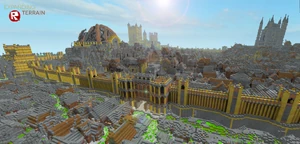
A screenshot showing off the old terrain system.
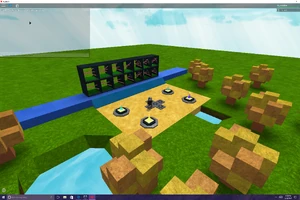
Old terrain in its existence in 2017.
The original terrain system, known as old terrain or legacy terrain, was a terrain type that was made up of many individual cells with simple shapes such as ramps, cubes and corner ramps.
Materials[]
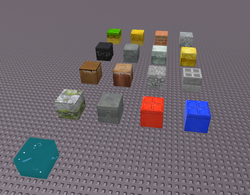
Terrain Materials before April 24 2014
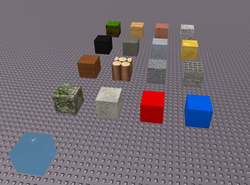
Terrain Materials on and after April 24 2014
The materials used for old terrain were:
- Grass
- Sand
- Brick
- Granite
- Asphalt
- Iron Plate
- Aluminum Plate
- Gold
- Wood Planks
- Logs
- Gravel
- Cinderblock
- Mossy Rock
- Concrete
- Red Plastic
- Blue Plastic
- Water
On August 19, 2016, Roblox deprecated old terrain, due to its low usage and high maintenance cost. It was scheduled to be removed on January 1, 2017.[5] This was later restated in a blog post.[6] Roblox encouraged usage of Smooth Terrain by giving developers an option to convert existing old terrain. In January 2017, it was officially replaced, as games with old terrain were converted. Games that still relied on old terrain were negatively impacted from this, such as Zombiesdale, which was known for its extensive use of old terrain.
Prevalence[]
The old terrain was criticized for two things: The first prominent point of controversy was that many players thought the old terrain resembled Minecraft's terrain. Although they were both voxel-based, blocky systems, they also had many differences. Old terrain had very different textures and used non-cube shapes such as wedges and corner wedges.
The second, perhaps more pressing issue for old terrain, was the significant amount of lag it caused. This was most prevalent in the 2014 Egg Hunt, which featured giant, terrain-based eggs floating in the lobby. Many players complained of the significant lag caused by this, alongside other technical issues that forced the egg hunt to shut down for maintenance.
Although old terrain was a novel feature for many users, most games continued to use traditional part-based maps instead. Most of the popular games from the time made little or no use of terrain. Even official events by Roblox, such as the Roblox Easter Egg Hunt 2013, went without terrain.
Among popular games that DID use this feature were the 2014 Egg Hunt, Build and Battle and ROBLOX Base Wars FPS. Although most large and popular games did not make use of the feature, it was incredibly popular with players who used Personal Servers and Build Mode.
Comparison to Smooth Terrain[]
Compared to Smooth Terrain, this terrain type was more suitable for building as the shapes were mostly flat.
Smooth Terrain is more smoother and more realistic compared to the blocky old terrain. Like old terrain, it still uses voxels. However, the voxels are subtle due to advanced technology used to produce smoother terrain.
Exploits[]
Terrain was vulnerable to exploiting, since terrain could be manipulated by any client. Game owners were able to solve this by turning on FilteringEnabled. This was ultimately fixed by Roblox with the forced FilteringEnabled update.
Gallery[]
Trivia[]
This section is a trivia section. Please relocate any relevant information into other sections of the article.
- By default, when spawning terrain, the deepest part of the terrain will always be cracked lava.
- Using the terrain generator and selecting the "caves" option will generate caves inside the terrain using rock. It is known that these caves are very deformed and that when entering, it is very difficult to get out of them.
References[]
- ↑ Shedletsky, John (2011, August 26). "The Terrain Game". From Roblox Blog. Accessed February 13, 2023. Archived from the original on March 8, 2013.
- ↑ Shedletsky, John (2011, October 7). "Land Grab!". From Roblox Blog. Accessed February 13, 2023. Archived from the original on August 8, 2022.
- ↑ https://blog.roblox.com/2012/06/the-water-is-running-in-roblox/
- ↑ zeuxcg (2015, June 1). "Create All New Worlds With Smooth Terrain". From Roblox Blog. Accessed February 13, 2023. Archived from the original on July 15, 2022.
- ↑ http://devforum.roblox.com/t/old-terrain-is-deprecated-and-will-be-removed-in-january-2017/28214
- ↑ https://blog.roblox.com/2016/08/announcing-deprecation-and-removal-of-old-terrain/
